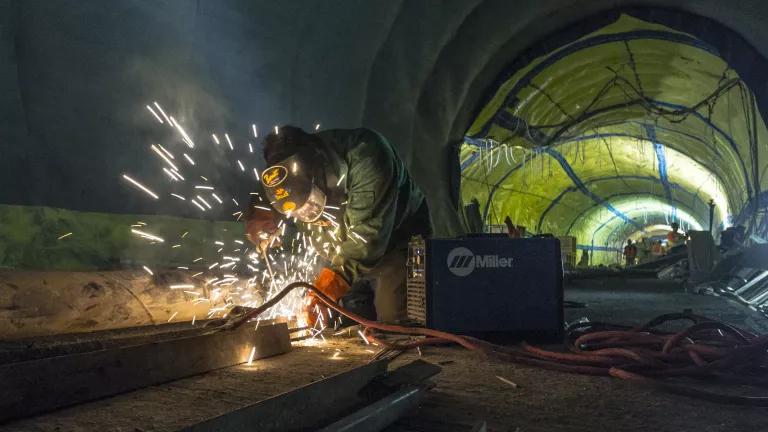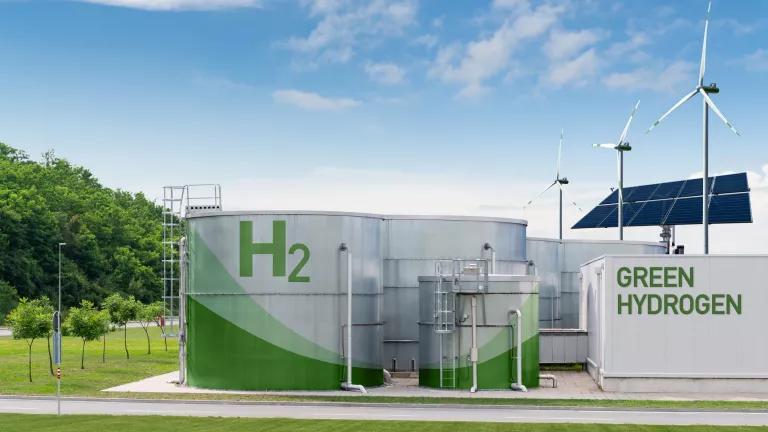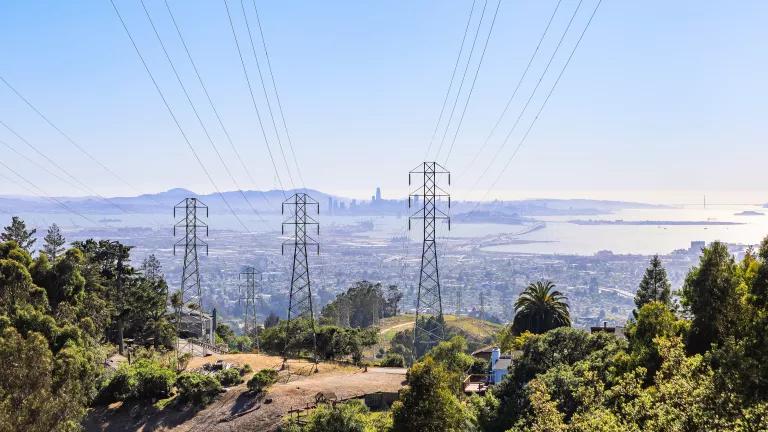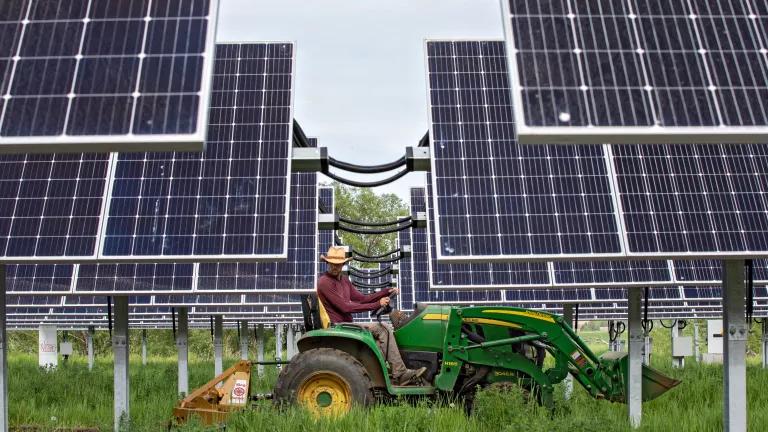A Blueprint for Advanced Industrial Manufacturing in New York
New York can lead the nation in low-carbon industrial manufacturing. Here is how.

A welder working on steel at an East Side Access Project site in Manhattan
Rehema Trimiew/MTA Capital Construction
New York can create good jobs, fight climate change, and capture billions of dollars in federal investment by supporting advanced, clean industrial manufacturing. Now is the critical moment to act. New York State recently passed a budget that anticipates new funding to meet goals set by the Climate Leadership and Community Protection Act (CLCPA). At the federal level, the U.S. Department of Energy (DOE) has started the process of rolling out billions of dollars in new spending for industrial decarbonization. New York should take advantage of its strong legacy of manufacturing, nation-leading climate goals, and significant purchasing power to seize the opportunity to become a hub of low-carbon industrial manufacturing. Here are a few ways the state can work to make that happen.
1. Work with private sector partners to secure federal funding:
Thanks to the Bipartisan Infrastructure Law and the Inflation Reduction Act (IRA), game-changing investments are now on the table to decarbonize heavy industry. These include the $8 billion regional clean hydrogen hubs program, the $6.3 billion Industrial Demonstrations Program, and the $10 billion 48C Advanced Manufacturing Tax Credit. Used well, these programs can help the United States slash emissions and create good jobs; the industrial initiatives in the IRA alone have the potential to create nearly 180,000 new jobs nationwide.
New York should help develop and support quality applications for relevant federal funding opportunities. Many private firms in the industrial sector lack the awareness of federal programs or the capacity to interface with the federal DOE on grant applications. New York State can bridge this gap with extension services aimed at advertising opportunities to support high-impact projects.
Local communities will be impacted by any new project, and the federal DOE has made it clear that, for its competitive funding opportunities, it will highly weigh the benefits that firms offer to local communities. Tribal and labor engagement will be key in this effort. New York should help firms develop significant and binding Community Benefit Agreements that can help attract federal spending to New York State and ensure the benefits are widely and justly shared. Complying with requirements set forth by the DOE as part of the clean hydrogen hubs application, New York engaged in a community engagement process around its hydrogen hubs proposal. The state could build on this process for future efforts and ensure that firms remain accountable to their commitments.
Additionally, because federal agencies are working against tight statutory time frames, an indication that state and local leaders support these projects can help build confidence that applicants will not face lengthy delays over issues like permitting.
2. Match federal incentives with state programs:
To complement new federal programs and create an extra incentive to locate projects in New York, the state should offer its own incentives for low-embodied carbon materials.
Energy-intensive, trade-exposed industries (EITEs) are a significant source of greenhouse gas (GHG) emissions that must be abated. At the same time, these industries produce commodities that are necessary for everyday life and are a source of good, family-sustaining jobs. As anticipated by the Scoping Plan for implementation of the CLCPA, the state should implement carefully crafted incentive-based strategies to encourage emissions reductions from EITEs. These strategies must include measures to deploy advanced technology that can deeply reduce emissions as well as requirements to hold firms accountable for promised climate and toxic pollution mitigation measures.
The recently passed state budget called for the creation of a new “climate investment account” to hold most of the revenue generated as part of programs to implement the CLCPA. Consistent with the purposes of this account, New York State should use new revenue to support deep decarbonization of large industrial facilities. An expanded version of the New York State Energy Research and Development Authority’s Commercial and Industrial Carbon Challenge program could be a good venue for this funding to run through. New York should also extend green economic development tax credits to include low-carbon production of industrial material and explore whether New York green bank financing can be made available for relevant projects.
Additionally, as New York State implements its climate agenda, EITEs will need carefully crafted sector-specific treatment to prevent leakage to jurisdictions with less stringent environmental and labor laws while ensuring in-state reductions of GHG and other toxic emissions. This may include the need for credits for a subset of industrial firms under any cap-and-invest program. Any discounted or free credits must be based on a set carbon intensity benchmark and tied to significant but achievable requirements to encourage firms to reduce emissions. Requirements should, at a minimum, include the creation of a clear and binding plan for mitigation of GHG and other pollution; continuous air pollution monitoring at covered facilities; public disclosure; and identification of actions that support economic and workforce development in fenceline communities. Over time, and in coordination with state incentives to invest in the deployment of emissions reduction technology at industrial firms, New York should include additional requirements on any credits offered under the program.
Carefully crafted industrial decarbonization incentive measures can help reduce emissions while attracting new federal investment and creating or retaining good jobs in New York State.
3. Buy low-carbon materials:
New York should use its immense purchasing power to support the use and production of low-embodied carbon materials. New York buys a large amount of high-emissions products like steel, cement, concrete, and aluminum. The state should build on public and private sector procurement programs, like Buy Clean programs and the First Movers Coalition, to build durable demand for low-carbon materials. These programs would create a guaranteed market for private sector actors that move first to cut emissions.
Embodied carbon—the carbon that is required to produce materials like steel, cement, and aluminum—is a significative driver of climate change. Heavy industry is responsible for 30 percent of U.S. economy-wide GHG emissions. Without strong measures to switch to clean technologies, that percentage is expected to increase through 2050. Embodied emissions from industrial materials can also undercut climate action on other fronts. Steel and aluminum, for instance, are necessary components of electric vehicles; roads, bridges, and rail systems use a significant amount of concrete and steel. As New York supports the build-out or repair of public infrastructure and the development of new housing, it should do its part to ensure the materials used are low carbon.
New York has already begun tackling embodied carbon. Last year, the state took steps to support use of low-carbon concrete. The Scoping Plan for implementation of the CLCPA also explicitly called for the state to create procurement incentives so that manufacturers will produce less emission-intensive goods to capitalize on the increased demand for such goods.
As an initial step to creating a comprehensive low-carbon procurement program, the state can require embodied carbon reporting for large public sector projects. The state should also convene a working group to set the state on a path to purchasing the lowest-carbon materials practically available while continuing to support implementation of the Low Embodied Carbon Concrete Leadership Act.
Now is the moment to act to transform the industrial sector. New York has the tools to get this done. If the state succeeds, it can lead the world on climate action while revitalizing manufacturing communities and decreasing pollution. It is a rare win-win-win that the state should not pass up.




